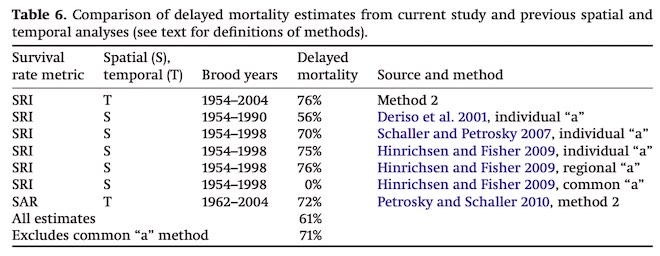forum
library
tutorial
contact

Salmon May Need
Dams to Survive
by Kurt Miller
Wenatchee World, November 11, 2020
|
the film forum library tutorial contact |

|
Salmon May Need
by Kurt Miller
|
Because of the tendency to blame Columbia Basin dams for poor salmon survival, we continue
to spend hundreds of millions of dollars a year trying to mitigate their supposed harms.
 One of my friends and colleagues suggested a headline for me over a year ago, "Our Salmon Need the Dams to Survive". Given conventional wisdom, this sounds like a contradiction.
One of my friends and colleagues suggested a headline for me over a year ago, "Our Salmon Need the Dams to Survive". Given conventional wisdom, this sounds like a contradiction.
We all know dams kill salmon, don't we? Why would salmon advocacy groups be fighting so hard to breach the lower Snake River dams if they are actually helping salmon?
But the point my friend was making is that significant research points to hostile ocean conditions caused by climate change as the primary driver of diminishing adult salmon returns across the West Coast of North America.
In fact, in 2020, three separate studies have shown the ocean is likely where we should be focusing our attention.
The first study, released by the National Oceanic and Atmospheric Administration Fisheries Service, showed Chinook salmon populations may face extinction in 20 to 30 years if the observed relationships between ocean temperatures and salmon survival remain steady, given the rapidly warming ocean. It also highlighted climate change appears to be a much bigger threat to Chinook salmon in the ocean than than in rivers.
The second study was released in Nature Communications and conducted by scientists at the University of Alaska. The researchers found the size of Chinook salmon in Alaska's rivers had declined significantly over the past 60 years, largely because salmon are returning after fewer years at sea. The scientists point to a more hostile ocean environment due to climate change and increased competition from hatchery-raised pink salmon.
During an interview with Clearing Up, one of the authors of the Alaskan study explained their findings have significant meaning for Columbia and Snake river salmon. He stated, "We know that fish in the Columbia have also gotten smaller -- the so-called spring hogs that would migrate way upstream are gone," he noted. "Something is going on in their shared environment, which, of course, is the ocean."
A third study published in the Journal of Fish and Fisheries conclusively demonstrated what many scientists have been speculating -- declines in Chinook salmon populations are not confined to the lower Snake River. Most of the rivers up and down the Pacific Coast have seen very similar declines of about 65% over the past 50 years.
This finding is consistent with NOAA Fisheries scientist Lisa Crozier's analysis. In 2019, Crozier noted researchers are seeing "near-synchronous declines" in worldwide salmon populations.
It's easy to understand why many would blame the lower Snake River dams for salmon declines -- because the construction of the dams coincided with this 50-year timeframe. But, if you look at the larger geographical scale, the conclusion of this peer-reviewed study is dams are not the limiting factor for Chinook salmon populations, despite our historical thinking.
Because of the tendency to blame Columbia Basin dams for poor salmon survival, we continue to spend hundreds of millions of dollars a year trying to mitigate their supposed harms. Environmental advocacy organizations also dedicate a tremendous amount of their energy and political capital to try to get the lower Snake River dams breached.
However, these three separate but reinforcing studies demonstrate the most recent science on this issue and have major implications for how Northwest policymakers now need to shift their thinking about endangered salmon and orca populations.
If these new studies are correct, surely we are wasting precious time and resources that should be dedicated to further reducing our carbon footprint and fighting climate change. In that case, the dams which produce millions of megawatt-hours of carbon-free electricity each year are a major part of the solution, not the problem.
It's time to adapt our thinking to what science is now revealing and consider salmon may in fact need the dams to survive.
Related Pages:
A synthesis of the coast-wide decline in survival of West Coast Chinook Salmon by David Welch, Aswea Porter, Erin Rechisky, Fish and Fisheries, September 17, 2020
learn more on topics covered in the film
see the video
read the script
learn the songs
discussion forum
